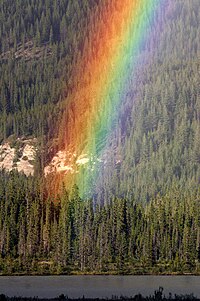Spectral color

Have you ever seen a rainbow? When the sun shines after the rain has stopped, you might see a beautiful arch of colors in the sky. Those colors – red, orange, yellow, green, blue, indigo, and violet – are called spectral colors. Spectral colors are the colors that make up white light, which is actually made up of different colors that blend together.
If you look really closely at a rainbow, you might notice that the colors fade into each other, almost like they're blending together. That's because each color has a different wavelength, which means they bend at slightly different angles in the air.
Scientists can study spectral colors using special tools called spectrometers. A spectrometer is like a fancy camera that can see colors that are too faint for our eyes to detect. When light passes through a spectrometer, it breaks down into its different colors and scientists can see the exact wavelengths and intensities of each color.
Spectral colors are important in many fields of science, including astronomy, physics, and chemistry. By studying the colors of stars, for example, scientists can learn about their temperature, size, and composition. In chemistry, scientists can use spectral colors to identify different elements based on the colors they produce when heated.
So, spectral colors might seem like magic, but they're actually just different colors of light that make up the world around us.
If you look really closely at a rainbow, you might notice that the colors fade into each other, almost like they're blending together. That's because each color has a different wavelength, which means they bend at slightly different angles in the air.
Scientists can study spectral colors using special tools called spectrometers. A spectrometer is like a fancy camera that can see colors that are too faint for our eyes to detect. When light passes through a spectrometer, it breaks down into its different colors and scientists can see the exact wavelengths and intensities of each color.
Spectral colors are important in many fields of science, including astronomy, physics, and chemistry. By studying the colors of stars, for example, scientists can learn about their temperature, size, and composition. In chemistry, scientists can use spectral colors to identify different elements based on the colors they produce when heated.
So, spectral colors might seem like magic, but they're actually just different colors of light that make up the world around us.
